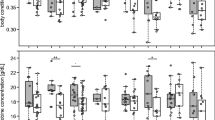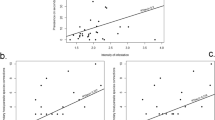Abstract
We studied the factors which regulate the reproduction of ectoparasites of temperate-zone cave-dwelling bats, using the Schreiber’s bat (Miniopterus schreibersii) and its ectoparasites as a model. For this, we searched 969 bats during 2003 and 2004 at important stages of the bat yearly cycle and found four ectoparasite species regularly occurring on them: two nycteribiids (Nycteribia schmidlii and Penicillidia conspicua), one wing mite (Spinturnix psi), and one hard tick (Ixodes simplex simplex). These parasites were present throughout the yearly cycle, but their reproductive activity greatly fluctuated seasonally. Also, we found that sex, age, and reproductive status of the host strongly influenced the reproductive activity of parasites. Overall, the four parasite species had a similar reproductive pattern, reproducing more intensively during the pregnancy and nursing seasons of M. schreibersii, mainly on pregnant and juvenile bats. Moreover, parasites greatly reduced reproductive activity during winter, while bats were in deep torpor or hibernating. We conclude that reproduction in ectoparasites of M. schreibersii and of many other temperate cave-dwelling bats is mostly regulated by the reproductive cycle of their bat hosts, but also limited by roost temperatures during winter. The fact that the reproductive cycle of parasite species of such distinct taxonomic groups are similarly adjusted to that of their bat host suggests that this adjustment is a highly adaptive trait.





Similar content being viewed by others
References
Altringham JD (1999) Bats: biology and behaviour. Oxford University Press, Oxford
Arthur DR (1956) The Ixodes ticks of Chiroptera (Ixodoidea: Ixodidae). Parasitology 142:180–196
Balcells E (1968) Revisión faunística de nicteríbidos y estréblidos de quirópteros españoles y su especificidad. Rev Iber Parasitol 28:21–31
Bartonička T, Gaisler J (2007) Seasonal dynamics in the numbers of parasitic bugs (Heteroptera, Cimicidae): a possible cause of roost switching in bats (Chiroptera, Vespertilionidae). Parasitol Res 100:1323–1330
Christe P, Arlettaz R, Vogel P (2000) Variation in intensity of a parasitic mite (Spinturnix myoti) in relation to the reproductive cycle and immunocompetence of its bat host (Myotis myotis). Ecol Lett 3:207–212
Combes C (2001) Parasitism: the ecology and evolution of intimate interactions. University of Chicago Press, Chicago
Crompton DWT (1987) Host diet as a determinant of parasite growth, reproduction and survival. Mammal Rev 17(2–3):117–126
Deunff J, Beaucournu JC (1981) Phenology and variations of dermecos in some species of Spinturnicidae (Acarina, Mesostigmata). Ann Parasitol Hum Comp 56:203–224
Dias D (1982) Contribuição o para o conhecimento dos ectoparasitas de quirópteros de Portugal (Acarina: Macronyssidae e Spinturnicidae). An Inst Hig Med Trop 8:3–14
Estrada-Peña A, Balcells E, Serra-Cobo J (1991a) Los artropodos ectoparasitos de murciélagos en España. Los murciélagos de España y Portugal. Colección Técnica ICONA, Madrid
Estrada-Peña A, Peribanez MA, Serra J (1991b) The life cycle of Spinturnix psi (Mesostigmata: Spinturnicidae) on Miniopterus schreibersii (Mammalia: Chiroptera). Modern acarology. Academia, Prague and SPB, The Hague
Evans GO (1968) The external morphology of the post-embryonic developmental stages of Spinturnix myoti Kol. (Acari: Mesostigmata). Acarologia 10:589–608
Grossman CJ (1985) Interactions between gonadal steroids and the immune system. Science 227:257–261
Imaz E, Aihartza JR, Totorika MJ (1999) Ectoparasites on bats (Gamasida, Ixodida, Diptera) in Biscay (N Iberian peninsula). Misc Zool 22:21–30
Ito A, Kano S, Hioki A, Kasuya S, Ohtomo H (1986) Reduced fecundity of Hymenolepis nana due to thymus-dependent immunological responses in mice. Int J Parasitol 16:81–85
Kennedy CR (1975) Ecological animal parasitology. Blackwell, Oxford
Lehane MJ (2005) The biology of blood-sucking insects. Cambridge University Press, Cambridge
Lourenço SI, Palmeirim JM (2007) Can mite parasitism affect the condition of bat hosts? Implications for the social structure of colonial bats. J Zool 273:161–168
Lourenço SI, Palmeirim JM (2008) How do ectoparasitic nycteribiids locate their bat hosts? Parasitology (accepted). doi:10.1017/S003118200800468X
Marshall AG (1970) The life cycle of Basilia hispida Theodor 1957 (Diptera: Nycteribiidae) in Malaysia. Parasitology 61:1–18
Marshall AG (1971) The ecology of Basilia hispida (Diptera: Nycteribiidae) in Malaysia. J Anim Ecol 40:141–154
Marshall AG (1981) The ecology of ectoparasitic insects. Academic, London
Minato K, Kimura E, Shintoku Y, Uga S (2008) Effect of temperature on the development of free-living stages of Strongyloides ratti. Parasitol Res 102:315–319
Newcombe RG (1998) Two-sided confidence intervals for the single proportion: comparison of seven methods. Stat Med 17:857–872
Overal WL (1980) Host-relations of the bat fly Megistopoda aranea (Diptera: Streblidae) in Panamá. Kansas Univ Sci Bull 52:1–20
Palmeirim JM, Rodrigues L (1995) Dispersal and philopatry in colonial animals: the case of Miniopterus schreibersii. Symp Zool Soc Lond 6:219–231
Poulin R (1996) The evolution of life history strategies in parasitic animals. Adv Parasitol 37:107–134
Quinnell RJ (1988) Host age and the growth and fecundity of Hymenolepis diminuta in the rat. J Helminthol 62:158–162
Radovsky F (1967) The Macronyssidae and Laelapidae parasitic on bats. University of California Press, Berkeley
Reckardt K, Kerth G (2006) The reproductive success of the parasitic bat fly Basilia nana (Diptera: Nycteribiidae) is affected by the low roost fidelity of its host, the Bechstein’s bat (Myotis bechsteinii). Parasitol Res 98:237–243
Reisen WK, Kennedy ML, Reisen NT (1976) Winter ecology of ectoparasites collected from hibernating Myotis velifer (Allen) in southwestern Oklahoma (Chiroptera: Vespertilionidae). J Parasitol 62(4):628–635
Rodrigues L, Palmeirim JM (2008) Migratory behaviour of Miniopterus schreibersii (Chiroptera): when, where, and why do cave bats migrate in a Mediterranean region. J Zool 274:116–125
Rudnick A (1960) A revision of the family Spinturnicidae. Univ Calif Publ Entomol 17:157–284
Ryberg O (1947) Studies on bats and bat parasites. Bokförlaget Svensk Natur, Stockholm
Seppälä O, Liljeroos K, Karvonen A, Jokela J (2008) Host condition as a constraint for parasite reproduction. Oikos 117:749–753
Shan LV, Zhou X, Zhang Y, Liu H, Zhu D, Yin W, Steinmann P, Wang W, Jia T (2006) The effect of temperature on the development of Angiostrongylus cantonensis (Chen 1935) in Pomacea canaliculata (Lamarck 1822). Parasitol Res 99:583–587
Sokal RR, Rohlf FJ (1995) Biometry: the principles and practice of statistics in biological research. W. H. Freeman, New York
Theodor O, Moscona A (1954) On bat parasites in Palestine. I. Nycteribiidae, Streblidae, Hemiptera, Siphonaptera. Parasitology 44:157–245
Tinsley RC (2004) Platyhelminth parasite reproduction: some general principles derived from monogeneans. Can J Zool 82:270–291
Travassos-Dias JA (1994) As carraças (Acarina: Ixodoidea) da Peninsula Ibérica. Algumas considerações sobre a sua biogeografia e relacionamento com a ixofauna afropaleárctica e afrotropical. Inst Invest Cient Trop, Lisboa
Tsai ML, Li JJ, Dai CF (2001) How host size may constrain the evolution of parasite body size and clutch size. The parasitic isopod Ichthyoxenus fushanensis and its host fish, Varicorhinus bacbatulus, as an example. Oikos 92:13–19
Yuval B (2006) Mating systems of blood-feeding flies. Annu Rev Entomol 51:413–414
Acknowledgments
We are very grateful to all our friends and colleagues who assisted with fieldwork, especially Luisa Rodrigues, Patricia Salgueiro, Tiago Marques, Maria João Pereira, and Sergio Chozas. Luísa Rodrigues and Instituto da Conservacão da Natureza e Biodiversidade (ICNB) provided logistical support and some data on temperatures within roosts. This work was conducted under permit of ICNB, complying with the current laws of Portugal. It is part of a PhD thesis that is supported by the Fundação para a Ciência e Tecnologia (FCT), co-financed by the European Regional Development Fund.
Author information
Authors and Affiliations
Corresponding author
Rights and permissions
About this article
Cite this article
Lourenço, S., Palmeirim, J.M. Which factors regulate the reproduction of ectoparasites of temperate-zone cave-dwelling bats?. Parasitol Res 104, 127–134 (2008). https://doi.org/10.1007/s00436-008-1170-6
Received:
Accepted:
Published:
Issue Date:
DOI: https://doi.org/10.1007/s00436-008-1170-6




